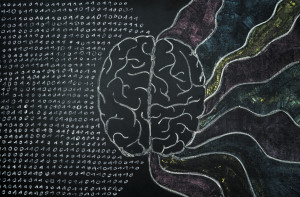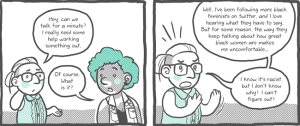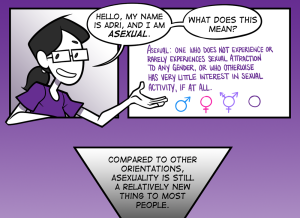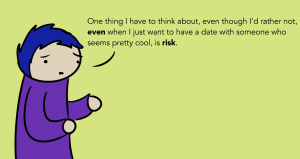
Source: iStock
With the rise in autism and other developmental and learning disability diagnoses over the last few decades, conversations around neurodiversity – which is the idea that neurological differences like autism and ADHD are the result of normal, natural variation in the human genome, not the result of disease or injury.
It’s a fairly new concept that’s gaining traction in the disability rights movement and is coming into the spotlight like never before.
And mainstream media outlets like Wired, The Atlantic, and Slate Magazine have been picking up on the budding social justice movement that’s attached to it. Steve Silberman’s new book Neurotribes, about the history of autism, is topping the bestseller charts.
You might wonder what disability and neurodiversity have to do with feminism. We tend to fall into the trap of thinking disability isn’t a feminist or social justice issue, because disability has been so entwined with medicine and the medical field for so long.
But if we take a closer look, we realize that disability has just as much to do with feminism as it does with medicine – maybe even more.
On the most basic of levels, feminism is about justice and equality for women. And obviously, there are many, many neurodivergent and/or disabled women, as well as disabled women who are intersectionally marginalized in the areas of race, sexual orientation, etc.
So, similar to issues of race and sexual orientation, we can’t talk about women without talking about neurodiversity.
If we exclude disabled women from the conversation, we’re missing out a huge chunk of the female population, just like we do when we don’t include women of color, non-heterosexual women, and trans or gender nonconforming women in our feminism.
But the issue goes much deeper.
The neurodiversity movement and the broader disability rights movement are a way to help push back against the stereotypes that feminists have been trying to smash for decades.
For example, a lot of girls and women with disabilities like autism and ADHD go underdiagnosed, because of tired old stereotypes about what boys and girls should act like.
In fact, Applied Behavioral Analysis, the foremost autism therapy today, was started primarily to “socialize” boys away from “feminine behaviors” so they would act more stereotypically masculine.
Feminism is all about allowing people of all genders autonomy and choice, regardless of gender stereotypes. The neurodiversity movement has the same principles in regard to differences in brains and minds.
Because of all this, it’s crucial for people invested in both feminism and disability justice to understand exactly what neurodiversity is – and what it isn’t.
Because I’m your friendly neighborhood neurodivergent person (you’ll find out what that means soon enough), I’m here to answer all your frequently asked questions about neurodiversity.
1. What Is Neurodiversity and The Neurodiversity Movement?
Neurodiversity is, according to activist Nick Walker, “the diversity of human brains and minds – the infinite variation in neurocognitive functioning within our species.”
Basically, it’s a fancy name for the fact that all our brains and minds are unique and individual. Like snowflakes, no two brains and no two minds are exactly alike.
Neurodiversity is a basic, biological fact, as evidenced by the broad array of functioning of minds and brains, which to some extent can be seen with technology like MRIs. The neurodiversity paradigm, as explained by Nick Walker, is an approach based on three principles:
- Neurodiversity is a natural and valuable form of human diversity.
- The idea that there is one “normal” or “healthy” type of brain or mind, or one “right” style of neurocognitive functioning, is a culturally constructed fiction – no more valid (and no more conducive to a healthy society or to the overall well-being of humanity) than the idea that there is one “normal” or “right” ethnicity, gender, or culture.
- The social dynamics that manifest in regard to neurodiversity are similar to the social dynamics that manifest in regard to other forms of human diversity (e.g., diversity of ethnicity, gender, or culture). These dynamics include the dynamics of social power inequalities, and also the dynamics by which diversity, when embraced, acts as a source of creative potential.
The neurodiversity paradigm is a collection of beliefs that stem from the biological fact of neurodiversity. It states that neurodiversity is normal, natural, and right, and that every type of mind, brain, etc. is valid.
In other words, no one type of mind or brain is “right” or “wrong.”
Diversity in all forms, including neurodiversity, creates social inequality, but it also can expand creativity. Neurodivergent people – who have neurological differences such as but not limited to autism dyslexia, developmental coordination disorder, or ADHD. – face social oppression. People whose minds and brains function in a way that’s considered “normal”, aka neurotypical people, are privileged in relation to neurodivergent people.
If we’re going with the snowflake analogy, the neurodiversity paradigm means that we don’t single out one particular type of snowflake (let’s say snowflakes with square shaped holes) as being “abnormal” and needing to be like the “normal” type of snowflakes (let’s say snowflakes with triangle shaped holes).
All snowflakes are “normal” and beautiful – just like all human minds/brains.
2. So, When We Talk About Neurodiversity, We’re Talking Specifically About Disabled People?
Neurodiversity doesn’t just apply to one group of people – neurodiversity is about everyone.
In the disability community, I’ve found that different categories of disability stand very much apart. Those with physical disabilities reject those with psychiatric disabilities and intellectual/cognitive disabilities. Those with cognitive or psychiatric disabilities reject those with physical disabilities.
No one is willing to work together and start to break down our internalized biases. This can make it difficult for someone like me, who has multiple disabilities that are not easily separated into discrete chunks.
The neurodiversity paradigm is the antithesis to this approach. When I found radical autistic activists, I felt more at home than I ever did among people who solely had my diagnoses, even though I’m not autistic.
People who value neurodiversity not only accept the way my body and mind work, but value the unique ways I experience life because of my disabilities.
Like other social justice concepts, the neurodiversity movement is about equality and appreciating the broad array of diversity within our species.
It, steeped in the principles of the neurodiversity paradigm, rejects the concept that brains that diverge from the norm are disordered or dysfunctional and that brains that don’t work in standard ways need to be fixed, treated, or cured.
In essence, the neurodiversity movement swims against the current of the medical model of disability, which is unfortunately the prevailing wisdom in our society when it comes to brains and bodies that work differently.
The medical model is extremely harmful, because at its core, it tells us that there is something “wrong” if our bodies and minds do not conform to an arbitrary definition of “normal.”
It makes us feel like outcasts and leads us to go to great (and often dangerous) lengths to make ourselves “normal.”
The medical model is grounded in the notion that there is only one “right” way to be. The medical model says that human beings are factory standard models, and any difference is a defect that must be corrected or thrown out.
Harmful therapies and treatments such as Applied Behavior Analysis, bleach enemas, and shock therapy (used at the infamous Judge Rotenberg Center) all grow out of the medical model impulse to “fix” neurodivergent and disabled people.
The neurodiversity movement has done incredible things in just a few short years. Organizations like Parenting Autistic Children with Love and Acceptance have sprung up centered around the ideals of the neurodiversity movement, helping parents who aren’t cure-oriented to get advice from autistic people themselves.
New concepts like Neuroqueer, fusing the principles of the neurodiversity movement and the queer rights movement, are gaining traction both inside and outside of academia.
Perhaps most importantly, the neurodiversity movement has provided community and solidarity for people like me, who have felt alienated from other disability spaces.
I found a home in the neurodiversity movement, and I know I’m not the only one.
3. Can I Disagree with the Neurodiversity Movement?
A lot of the disagreement surrounding the neurodiversity movement is based on misinformation. Some people think that rejecting the medical model means that we don’t think of conditions such as autism, ADHD, or other neurodivergences as disabilities.
That’s not true at all! We fully recognize that disabilities can be, well, disabling!
When we say we believe in the neurodiversity paradigm, we’re not saying our lives are all butterflies and sunshine — we’re saying that our minds are normal and natural for us, and we shouldn’t be subjected to attempts to cure or fix us.
If we choose for ourselves to seek treatment or a cure for the parts of our disabilities that are distressing or difficult, that’s fine.
I would give anything to cure my generalized anxiety disorder and OCD. But we reject the idea that there’s something “wrong” with us because of the way our brains work.
The neurodiversity paradigm is about saying that all ways of thinking and being are right and valid, and there is no one “right” way to be, just as no one snowflake is the “right” way for a snowflake to look.
When you say you disagree with neurodiversity, you’re really saying you disagree with the principles that form the neurodiversity paradigm and drive the neurodiversity movement, a social justice movement based on the neurodiversity paradigm and advocating for equality.
However, you can’t disagree with the fact of neurodiversity.
4. Am I Neurodiverse?
It depends on what you mean by that. Humans, as a species, are neurodiverse because no two people’s minds and brains are the same.
But if you mean that your brain/mind doesn’t function in a way that’s considered “normal,” then yes, that means you’re neurodivergent. Being neurodivergent means that your brain and mind don’t function in conventional ways.
Early autistic activists in the 1990s recognized that many people with diagnoses like these thought and acted in ways similar to autistic people, but weren’t autistic. This led autistic activist Kassiane Sibley to coin the term “neurodivergent,” specifically to fill the need for a term with a wider definition that didn’t center autism.
The neurodiversity movement is still mostly led by autistic people and autism is an example of a specific form of neurodivergence, but neurodiversity is not just about autism at all.
Some examples of people who are neurodivergent are people with psychiatric disabilities (depression, anxiety, schizophrenia, bipolar, etc.), people with developmental/intellectual disabilities (autism, Down Syndrome, other types of intellectual disability), and people with learning disabilities such as dyslexia, dyscalculia, etc.
But this isn’t an exhaustive list! For instance, I’m multiply neurodivergent because I have cerebral palsy, generalized anxiety disorder, and OCD. All of these conditions affect how my brain and mind function.
Even if you’re not formally diagnosed, recognizing that your mind and brain work in non-typical ways can be a powerful and life-changing realization.
For me, I focused on my physical disabilities for so long that when I started meeting neurodivergent people who had some of the same difficulties that I did, it was exciting and refreshing.
Our society tells us that we can overcome anything and be “normal” if we only try hard enough. It also highly stigmatizes neurodivergence. I’m usually not embarrassed when using my mobility aids in public, but as soon as I have an anxiety attack in public, I’m deeply ashamed.
Identifying as neurodivergent has helped me understand that the way my brain works isn’t my fault, and it’s not bad or wrong. It has also helped me stand up for my access needs when I need to, because I recognize that the way my brain works isn’t something I have to push through or get over.
The neurodiversity paradigm and the neurodiversity movement are about recognizing that all minds and brains are valid and important.
5. What Does Neurotypical Mean, Then?
Neurotypical (NT) is the opposite of neurodivergent. Neurotypical means that your brain and mind function in ways that fit within conventional, “normal” parameters.
It is not the same as allistic, which means not autistic. As we already established, neurodiversity and neurodivergence goes far beyond just autism. When autistic or other neurodivergent people say that someone is allistic or neurotypical, a lot of times they’re talking about experience and privilege.
People whose brains work in societally accepted ways do not have the same experiences and do not face the same stigma as those whose brains diverge from the norm.
Like other forms of oppression, that doesn’t mean that allies don’t have a place in the discussion – it just means that they need to sit back and let marginalized people take the lead.
Unfortunately, this can make some people feel defensive. Without a good understanding of how oppression and privilege work, some potential allies can feel like they’re being shut out of the conversation and insulted with terms they don’t understand.
But the words “neurotypical” and “allistic” aren’t slurs or labels with any sort of feeling behind it. They’re neutral descriptors.
6. Does Being Neurotypical Mean that I’m Not Disabled?
No. It just means that your brain and mind function in a state that is considered “normal.”
There are plenty of disabilities that don’t affect the brain and mind, but are still disabilities. Amputees are disabled, but their disabilities don’t affect their brains, so they’re neurotypical (unless, of course, they have another disability which affects their brain/mind).
Alternately, there are some neurodivergent people who don’t consider themselves disabled, particularly those who identify as having mental illness/psychiatric disabilities, or who identify as psychiatric survivors.
The line isn’t absolute, either. There is some debate about whether sensory impairments such as blindness and deafness, which don’t necessarily affect the mind in the way we typically think of it, but could affect the way the brain processes information, are counted as neurodivergences.
7. What If I Want to Learn More?
Nick Walker’s blog, Neurocosmopolitanism, is a great place to start, and where I got most of my information for this piece.
Kassiane Sibley’s blog, Radical Neurodivergence Speaking has a lot of good information on autism oppression and the dual neurodivergences of autism and epilepsy.
Jim Sinclair’s “Don’t Mourn for Us” and “Why I Dislike Person-First Language” are seminal pieces not only in the autism rights movement, but the broader neurodiversity rights movement as well.
Julia Bascom’s “On Quiet Hands” is another seminal piece that launched an amazing video and an incredible anthology.
Neuroqueer is a concept and a movement fusing together the ideals of queer and neurodivergent communities.
Neurodiversity and the neurodiversity paradigm are still very much “in” concepts, with “in” language, meaning that no one outside of a specific group of people really know what it is.
Hopefully, this piece will go a long way towards changing that. Though you may feel like you’ve failed a vocabulary test by this point, don’t worry.
The words are important, but what’s more important are the concepts behind the words – concepts like embracing everyone, regardless of the way their brains work, even if their brains work in a way we don’t quite understand.
We live in a neurodiverse world. It’s time we began to embrace that.
[do_widget id=’text-101′]
Cara Liebowitz is a Contributing Writer for Everyday Feminism. She is a multiply-disabled activist and writer currently pursuing her M.A in Disability Studies at the CUNY School of Professional Studies in Manhattan. Her published work includes pieces in Empowering Leadership: A Systems Change Guide for Autistic College Students and Those with Other Disabilities, published by the Autistic Self Advocacy Network, and the Criptiques anthology. Cara blogs about disability issues large and small at That Crazy Crippled Chick. You can check her out on Twitter @spazgirl11.
Search our 3000+ articles!
Read our articles about:
Our online racial justice training
Used by hundreds of universities, non-profits, and businesses.
Click to learn more



















